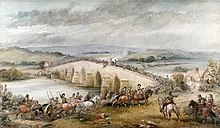Philip Twisleton
Philip Twisleton | |
|---|---|
 19th century engraving of the fight for Preston Bridge, part of the Battle of Preston | |
| Personal details | |
| Born | Uncertain, probably c. 1616 Drax, North Yorkshire |
| Died | 13 June 1678 (aged 61) Horsmans Place, Kent |
| Nationality | English |
| Spouse | Ann Brograve |
| Children | John (died 1721); Thomas |
| Military service | |
| Allegiance | Parliamentarian |
| Years of service | 1642 to 1660 |
| Rank | Colonel |
| Battles/wars | |
Philip Twisleton, born c. 1616, died 13 June 1678, was a member of the landed gentry from North Yorkshire, who served as a colonel in the New Model Army during the Wars of the Three Kingdoms.
Biography
[edit]Philip Twisleton was the son of John Twislkton, of Drax and Barley, Yorkshire, and of Horsmans Place in Dartford, and Margaret, daughter of William Constable.[1] He had an elder brother, John (1614–1682), and a younger, George (1618–1667), who also served in the Parliamentarian army.
Twisleton was colonel of a cavalry regiment in the New Model Army,[2] and was knighted by Oliver Cromwell, the Lord Protector, on 1 February 1658. The knighthood was voided after the Stuart Restoration in May 1660.[3][1]
Family
[edit]Philip Twisleton married Ann, daughter of John Brograve (born 1597) of Hamells and Hannah, daughter of Sir Thomas Barnardiston.[4] They had two sons:
- John (died 1721), the eldest son and heir, who inherited Horsmans Place from his uncle John and died childless.[5]
- Thomas, who became a reverend and had at least one child, a daughter named Mary.[6]
References
[edit]- ^ a b Cokayne 1903, p. 5.
- ^ Reid 2004, p. 40.
- ^ Shaw 1906, p. 224.
- ^ Burke 1838, p. 82.
- ^ Dunkin 1844, p. 296.
- ^ Peile 1910, p. 163.
Sources
[edit]- Burke, John (1838), A genealogical and heraldic history of the extinct and dormant baronetcies of England, by J. and ..., London: Scott, Webster and Grey, p. 82
- Cokayne, George Edward, ed. (1903), Complete Baronetage 1649–1664, vol. 3, Exeter: William Pollard and Co, p. 5
- Dunkin, John (1844), The History and Antiquities of Dartford, with Topographical Notices of the Neighbourhood, John Russell Smith, pp. 296
- Peile, John (1910), Venn, John Archiabald (ed.), Biographical register of Christ's College, 1505-1905, and of the earlier foundation, God's house, 1448-1505, vol. 2, Cambridge University Press, p. 163
- Shaw, William Arthur (1906), The Knights of England: A complete record from the earliest time to the present day of the knights of all the orders of chivalry in England, Scotland, and Ireland, and of knights bachelors, incorporating a complete list of knights bachelors dubbed in Ireland, vol. 2, London: Sherratt and Hughes
- Reid, Stuart (2004). Dunbar 1650: Cromwell's Most Famous Victory. Osprey Publishing. p. 40. ISBN 9781841767741.
